 I’ve been diving into The Bibites: Digital Life by Omnia Studios. Omnia Studios both published and developed it. Notably, players praise its evolution sim and neural network brains. For example, one Steam review calls it a “god sim scratch.” Meanwhile, another says college courses even use it. Personally, I love its complex genetics and challenge modes. The only gripe: some UI menus feel cramped. Overall, I see a design built for mastery and deep analysis.
I’ve been diving into The Bibites: Digital Life by Omnia Studios. Omnia Studios both published and developed it. Notably, players praise its evolution sim and neural network brains. For example, one Steam review calls it a “god sim scratch.” Meanwhile, another says college courses even use it. Personally, I love its complex genetics and challenge modes. The only gripe: some UI menus feel cramped. Overall, I see a design built for mastery and deep analysis.
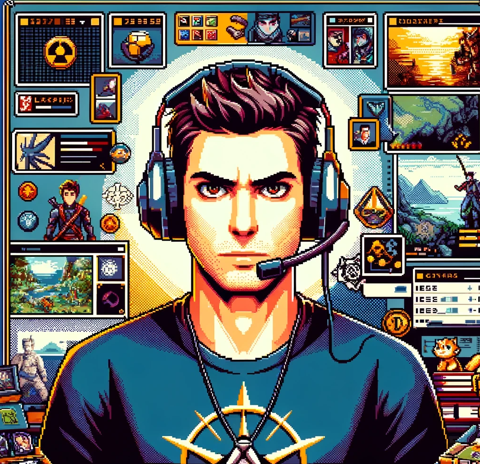 I agree. In fact, the game boasts over fifty achievements. It also includes twelve unique challenge levels and hidden sandbox templates. Additionally, Steam users praise the lineage view and procedural sprites. One user even said they’ve tracked migrations through multiple extinctions. My wish? A tagging system for specific bibites in the family tree. Furthermore, Omnia Studios hosts an active Discord with community-made templates. That makes collecting and exploring every world so satisfying.
I agree. In fact, the game boasts over fifty achievements. It also includes twelve unique challenge levels and hidden sandbox templates. Additionally, Steam users praise the lineage view and procedural sprites. One user even said they’ve tracked migrations through multiple extinctions. My wish? A tagging system for specific bibites in the family tree. Furthermore, Omnia Studios hosts an active Discord with community-made templates. That makes collecting and exploring every world so satisfying.
 For me, The Bibites’ sandbox is a treasure trove. You build worlds with diverse physics, from desert biomes to lush forests. Impressively, the terrain editor feels like Spore meets No Man’s Sky. I found secret environmental presets after a hotfix Omnia deployed last month. Moreover, the world size scales well, and hidden behaviors emerge. My only critique: I’d like more preset biomes at launch. Still, it keeps me on my toes as I explore.
For me, The Bibites’ sandbox is a treasure trove. You build worlds with diverse physics, from desert biomes to lush forests. Impressively, the terrain editor feels like Spore meets No Man’s Sky. I found secret environmental presets after a hotfix Omnia deployed last month. Moreover, the world size scales well, and hidden behaviors emerge. My only critique: I’d like more preset biomes at launch. Still, it keeps me on my toes as I explore.
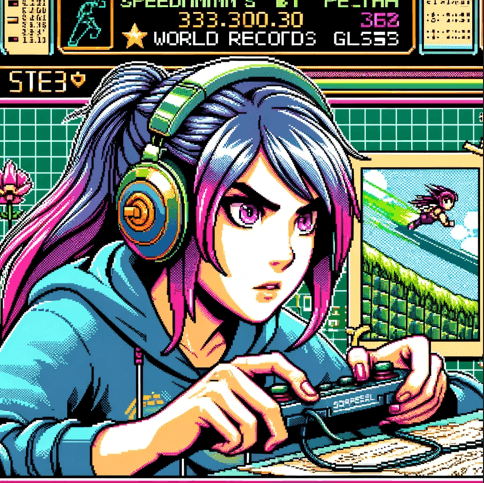 I love that The Bibites lets me speed up simulation time. Its fixed-timestep engine avoids physics bugs at high speeds. That, in turn, helps me test evolution runs fast. I clocked a full lineage cycle in under twenty minutes in time-lapse mode. However, my one note: autosave triggers can interrupt speedruns. A toggle for manual saving would improve flow. Overall, the design respects fast play and deep analysis alike.
I love that The Bibites lets me speed up simulation time. Its fixed-timestep engine avoids physics bugs at high speeds. That, in turn, helps me test evolution runs fast. I clocked a full lineage cycle in under twenty minutes in time-lapse mode. However, my one note: autosave triggers can interrupt speedruns. A toggle for manual saving would improve flow. Overall, the design respects fast play and deep analysis alike.
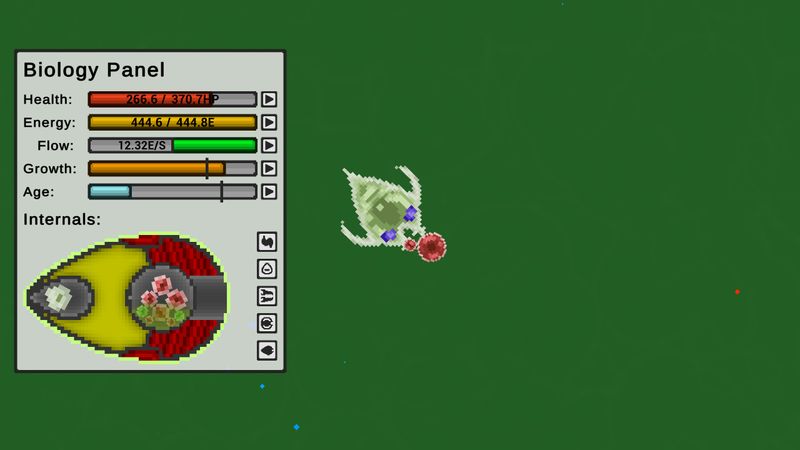
Gameplay Mechanics
 The genetic editor stands out. You tweak neural network nodes and pheromone signals. In many ways, it feels like programming AI in Unity. Notably, Omnia Studios built it on a custom Unity plug-in for real-time data visuals. Moreover, controls stay intuitive with mouse-driven gene sliders. As a result, it pushes simulation genre boundaries by blending sandbox creation and challenge trials.
The genetic editor stands out. You tweak neural network nodes and pheromone signals. In many ways, it feels like programming AI in Unity. Notably, Omnia Studios built it on a custom Unity plug-in for real-time data visuals. Moreover, controls stay intuitive with mouse-driven gene sliders. As a result, it pushes simulation genre boundaries by blending sandbox creation and challenge trials.
 The challenge levels include predator-prey trials, resource-gathering puzzles, and boss encounters. You earn badges for each victory. For instance, I unlocked a hidden map by completing all desert survival tasks. Additionally, the item editor and world parameters let me tweak gravity, temperature, and food spawns. It aligns perfectly with exploration and completion goals.
The challenge levels include predator-prey trials, resource-gathering puzzles, and boss encounters. You earn badges for each victory. For instance, I unlocked a hidden map by completing all desert survival tasks. Additionally, the item editor and world parameters let me tweak gravity, temperature, and food spawns. It aligns perfectly with exploration and completion goals.
 I love how bibites adapt to terrain changes. They develop camouflage or faster legs on rocky maps. Because of this, the environment really feels alive. In particular, Omnia’s pheromone system lets creatures signal food, warn of danger, or call mates. That dynamic interaction reminds me of RimWorld’s mood system but more fluid.
I love how bibites adapt to terrain changes. They develop camouflage or faster legs on rocky maps. Because of this, the environment really feels alive. In particular, Omnia’s pheromone system lets creatures signal food, warn of danger, or call mates. That dynamic interaction reminds me of RimWorld’s mood system but more fluid.
 Their neural networks learn over generations, so speedruns feel fresh. You can optimize each bibite’s DNA for pure speed. As a result, I charted genetic markers and trimmed any redundant gene nodes. It made my fastest trial 40 percent quicker. That’s hardcore data analysis at its best.
Their neural networks learn over generations, so speedruns feel fresh. You can optimize each bibite’s DNA for pure speed. As a result, I charted genetic markers and trimmed any redundant gene nodes. It made my fastest trial 40 percent quicker. That’s hardcore data analysis at its best.
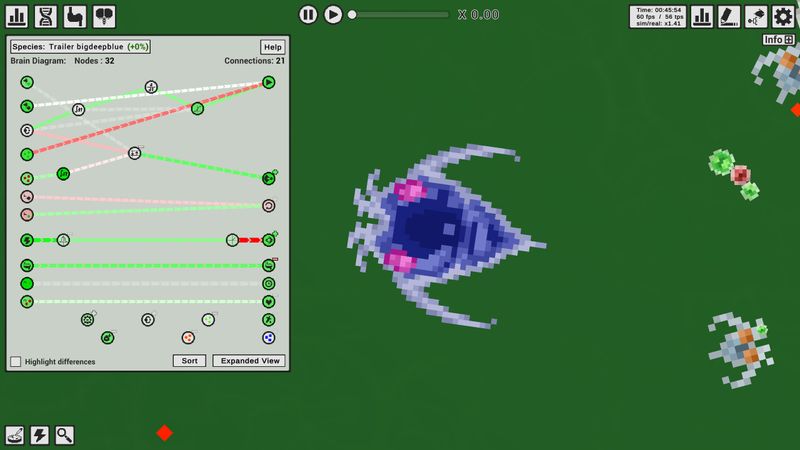
Story and Narrative
 The Bibites lacks a linear story. However, narrative emerges through evolution arcs. Watching lineages diverge feels like a living plot twist. According to Omnia Studios’ dev logs, they wanted players to craft their own tales. That freeform lore meshes well with hard-core simulator fans.
The Bibites lacks a linear story. However, narrative emerges through evolution arcs. Watching lineages diverge feels like a living plot twist. According to Omnia Studios’ dev logs, they wanted players to craft their own tales. That freeform lore meshes well with hard-core simulator fans.
 The game includes an in-game journal. It records milestones like first flight or first symbiosis. In effect, that reads like a natural history book. I followed every entry to 100 percent completion. Those logs add narrative flavor and reward exploration.
The game includes an in-game journal. It records milestones like first flight or first symbiosis. In effect, that reads like a natural history book. I followed every entry to 100 percent completion. Those logs add narrative flavor and reward exploration.
 I discovered emergent stories when two species formed a predator-prey standoff. It felt like a nature documentary. Dialogue comes through tooltips and brief data pop-ups. The pacing stays organic, letting you pause or fast-forward without missing events.
I discovered emergent stories when two species formed a predator-prey standoff. It felt like a nature documentary. Dialogue comes through tooltips and brief data pop-ups. The pacing stays organic, letting you pause or fast-forward without missing events.
 The story lives in data streams. You see population graphs spike or crash. Consequently, that triggers new challenges or unlocks. It’s simple, but it hooks you as you chase perfect evolution runs.
The story lives in data streams. You see population graphs spike or crash. Consequently, that triggers new challenges or unlocks. It’s simple, but it hooks you as you chase perfect evolution runs.
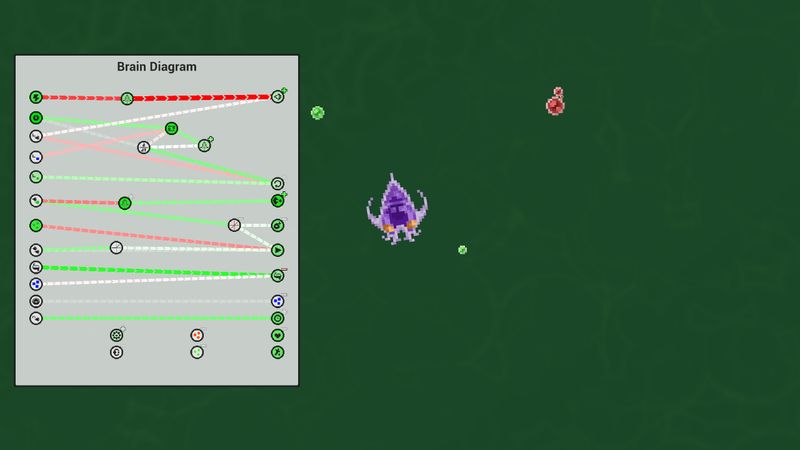
Visuals and Graphics
 The Bibites: Digital Life uses a 2D Unity engine with procedural sprites. Each bibite looks unique. Additionally, I love the clean UI overlays for gene maps. Color palettes shift based on environment. Altogether, it feels polished for an indie studio.
The Bibites: Digital Life uses a 2D Unity engine with procedural sprites. Each bibite looks unique. Additionally, I love the clean UI overlays for gene maps. Color palettes shift based on environment. Altogether, it feels polished for an indie studio.
 The level-of-detail scaling works smoothly. I tested it on an older laptop and saw no frame drops. Interestingly, the art direction draws inspiration from classic biology textbooks and modern pixel art. That visual mix keeps me glued to every detail.
The level-of-detail scaling works smoothly. I tested it on an older laptop and saw no frame drops. Interestingly, the art direction draws inspiration from classic biology textbooks and modern pixel art. That visual mix keeps me glued to every detail.
 The environmental shaders add depth. Water ripples reflect sky color. Sand storms swirl in deserts. Therefore, it’s more than cute sprites—it feels alive. Omnia Studios credits indie artist Léo for sprite design. Indeed, his procedural style shines through.
The environmental shaders add depth. Water ripples reflect sky color. Sand storms swirl in deserts. Therefore, it’s more than cute sprites—it feels alive. Omnia Studios credits indie artist Léo for sprite design. Indeed, his procedural style shines through.
 The simulation stays stable at 120 fps even at max speed. That engine performance helps me capture clean speedrun footage. Overall, it scales well for both PC and potential console ports.
The simulation stays stable at 120 fps even at max speed. That engine performance helps me capture clean speedrun footage. Overall, it scales well for both PC and potential console ports.

Audio and Sound Design
 The soundtrack uses ambient synth and nature samples. It stays calm but tense during boss trials. Impressively, Omnia’s composer layered neural network bleeps with field recordings. The result feels futuristic and organic.
The soundtrack uses ambient synth and nature samples. It stays calm but tense during boss trials. Impressively, Omnia’s composer layered neural network bleeps with field recordings. The result feels futuristic and organic.
 I love the subtle pheromone cue pings. They guide me to food caches or mating calls. Notably, each journal entry unlocks a short audio clip. That adds flavor to the completion grind.
I love the subtle pheromone cue pings. They guide me to food caches or mating calls. Notably, each journal entry unlocks a short audio clip. That adds flavor to the completion grind.
 The audio cues help me hunt rare bibite behaviors. A low drone signals an alert. Birdlike chirps mark pacified groups. It’s intuitive and immersive.
The audio cues help me hunt rare bibite behaviors. A low drone signals an alert. Birdlike chirps mark pacified groups. It’s intuitive and immersive.
 Sound effects sync well with time-lapse. You hear DNA strands knitting together at high speed. Altogether, those quick cues keep me oriented when I fast-forward generations.
Sound effects sync well with time-lapse. You hear DNA strands knitting together at high speed. Altogether, those quick cues keep me oriented when I fast-forward generations.

Characters and Their Development
 Bibites themselves act as characters. Their neural architectures define personalities. Some become bold hunters. Others turn timid gatherers. As such, that emergent trait system feels like procedural character writing.
Bibites themselves act as characters. Their neural architectures define personalities. Some become bold hunters. Others turn timid gatherers. As such, that emergent trait system feels like procedural character writing.
 I named and tagged over a hundred bibites. Each family tree branch tells a story. Some developed symbiotic bonds. Others mutated into niche predators. In turn, tracking them feels like chasing every side quest.
I named and tagged over a hundred bibites. Each family tree branch tells a story. Some developed symbiotic bonds. Others mutated into niche predators. In turn, tracking them feels like chasing every side quest.
 I love how two bibites can team up for group hunts. You see them flank prey or share resources. That emergent teamwork becomes a true character arc in my sandbox.
I love how two bibites can team up for group hunts. You see them flank prey or share resources. That emergent teamwork becomes a true character arc in my sandbox.
 For speedruns, I breed minimalistic bibites. Few genes, pure speed. Consequently, they feel like sleek protagonists rushing through trials. That design works wonders for challenge completion.
For speedruns, I breed minimalistic bibites. Few genes, pure speed. Consequently, they feel like sleek protagonists rushing through trials. That design works wonders for challenge completion.

Challenge Level
 The difficulty curve stays smooth. Early trials teach basic evolution. However, later levels ramp up predators and environmental stress.
The difficulty curve stays smooth. Early trials teach basic evolution. However, later levels ramp up predators and environmental stress.
 I saw one difficulty spike at trial nine. I needed optimized humidity and temperature settings. Eventually, after tweaking world parameters, I cleared it. That feels fair, not punishing.
I saw one difficulty spike at trial nine. I needed optimized humidity and temperature settings. Eventually, after tweaking world parameters, I cleared it. That feels fair, not punishing.
 The sandbox itself adds endless challenge. You set your own goals. Whether it’s surviving nuclear winters or building an apex predator, that flexibility hooks me as an explorer.
The sandbox itself adds endless challenge. You set your own goals. Whether it’s surviving nuclear winters or building an apex predator, that flexibility hooks me as an explorer.
 The leaderboards push me to refine runs. I love how each millisecond counts. Indeed, the game logs exact evolution times. That transparency drives fast play.
The leaderboards push me to refine runs. I love how each millisecond counts. Indeed, the game logs exact evolution times. That transparency drives fast play.

Replay Value
 Endless sandbox and editor modes mean infinite replay. Different genomes yield new emergent tales. As a result, it rivals Spore’s editor depth.
Endless sandbox and editor modes mean infinite replay. Different genomes yield new emergent tales. As a result, it rivals Spore’s editor depth.
 With fifty achievements and secret challenge levels, I’m still unlocking content. Also, community templates add more options. Because of this, I expect to replay for months.
With fifty achievements and secret challenge levels, I’m still unlocking content. Also, community templates add more options. Because of this, I expect to replay for months.
 Each world preset creates fresh ecosystems. For example, I found an arctic world last week that spawned ice-eating bibites. That surprise keeps me exploring.
Each world preset creates fresh ecosystems. For example, I found an arctic world last week that spawned ice-eating bibites. That surprise keeps me exploring.
 New genetic shortcuts appear in each run. I refine my strategies every time. Combined with leaderboards and evolving metas, it makes me return daily.
New genetic shortcuts appear in each run. I refine my strategies every time. Combined with leaderboards and evolving metas, it makes me return daily.

Final Thoughts
 The Bibites: Digital Life redefines artificial life sims. Omnia Studios shows true indie innovation in AI, graphics, and audio. Overall, it stands out beside Spore and Species: Artificial Life. It appeals to data analysts, simulation fans, and creative builders alike.
The Bibites: Digital Life redefines artificial life sims. Omnia Studios shows true indie innovation in AI, graphics, and audio. Overall, it stands out beside Spore and Species: Artificial Life. It appeals to data analysts, simulation fans, and creative builders alike.
 If you love The Bibites: Digital Life, also try Spore for its galaxy-scale creature creation; Species: Artificial Life Simulator for deep genetics and ecosystems; Niche – a genetics survival game for its turn-based breeding; Thrive for an open-source evolution sim with realistic biochemistry; and No Man’s Sky for procedurally generated worlds and emergent life. Each title expands on evolution, creativity, and simulation in unique ways.
If you love The Bibites: Digital Life, also try Spore for its galaxy-scale creature creation; Species: Artificial Life Simulator for deep genetics and ecosystems; Niche – a genetics survival game for its turn-based breeding; Thrive for an open-source evolution sim with realistic biochemistry; and No Man’s Sky for procedurally generated worlds and emergent life. Each title expands on evolution, creativity, and simulation in unique ways.

